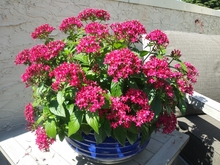A University of Minnesota Extension Master Gardener shares thoughts on edible landscapes, pollinators and volunteering.
Jennifer Knutson has more to do this winter than drool over seed catalogs and their full-color promises of spring. A slew of speaking engagements and a weekly column call for her time.
Knutson, who just ended her term as president of the Extension Master Gardeners in Crow Wing County and now lives in Minnetonka, took time to answer some questions.
What inspires you to get involved? Don’t most gardeners prefer quiet time alone?
I feel a sense of peace and connection with nature when I'm working in gardens. It's almost like a meditative experience, but I also enjoy sharing my knowledge and love of gardening with other people.
There's a huge resurgence in gardening since the onset of the COVID-19 pandemic. It’s been more important than ever to get research-based knowledge out there.
You write a column in the Brainerd Dispatch. How has that been received?
I've been writing it since about a year after becoming a Master Gardener in 2007. I include photos to make it come alive, and it’s become one of the most-read parts of the paper. It’s gone from monthly to coming out every week.
Why do you focus on ornamental plants instead of vegetables that feed people?
A lot of beautiful shrubs bear fruit, like honeyberries and serviceberries. I've used leaf lettuce as flower-garden edging. Chives and herbs fill in well among flowers. You can incorporate edibles into ornamental gardens, and that's what I try to do.
What about non-edible ornamental plants? Why grow them, other than for beauty?
I push for using as many native flowering plants as possible to feed nectar to pollinators.
One of my new favorites is Agastache foeniculum, the common name is anise hyssop, which attracts bees and butterflies the entire six to eight weeks it’s in bloom. On my deck, I’ll plant a big pot of pentas, which are a non-native annual, but hummingbirds love them.
Flowering plants also attract insects for birds to eat for the protein they need. I encourage people not to cut everything down in the fall. Keep the Black-eyed Susans and coneflowers up throughout the winter. The seed heads will help nourish the birds.
What are some of your other favorite flowers?
My son and I both love lilies. Peonies and clematis are two of my other favorites.
Who introduced you to gardening?
My maternal grandparents in Madison Lake, Minn., had a big influence on me. I helped my grandfather harvest vegetables and learned how to take care of roses at an early age. I learned the Latin botanical names from books he gave me. Now when I present, the botanical name comes to mind first, and it'll take me a moment to come up with the common name.
Gardens and children do go well together, and Master Gardeners have helped establish schoolyard gardens. Can you talk about that?
I know a lot of schools because I'm an educator, so I see schoolyard gardens being used in science education and in many other ways, teaching children to become stewards of the environment. Quite a few schools are putting in butterfly gardens or monarch waystations, as well as growing food.
How do you keep up to date?
I really have to keep up in order to write the weekly column. I take courses at the University of Minnesota and through the Minnesota Landscape Arboretum. I have an extensive horticulture library at home, and I subscribe to magazines like Northern Gardener. I like to practice my French, so I even receive one gardening magazine from France.
I visit the University of Minnesota Extension website all the time, as well as other University Extension or state agency sites.
Do you have any thoughts to share for anyone who's considering volunteering with Extension?
Everyone has different strengths and different interests. Some people are scared to speak in public and some people are good at it. Some people don't like to write, and some do. Some like that hands-on work on pilot projects at the Arboretum.
You can find your place in the Master Gardener program if you want to take the love of your hobby and share your knowledge and enthusiasm with others.
Related stories

Think 2022: Top 10 annual flowers
Results from the 2021 Annual Flower Trial conducted at the University of Minnesota West Central Research and Outreach Center in Morris with nearly 500 varieties.

Garden activities coax memories into bloom
University of Minnesota Extension Master Gardener volunteers help elders and people with memory disorders — and their caregivers



